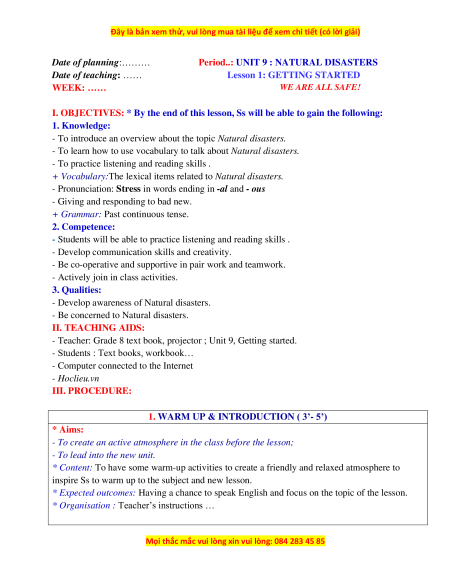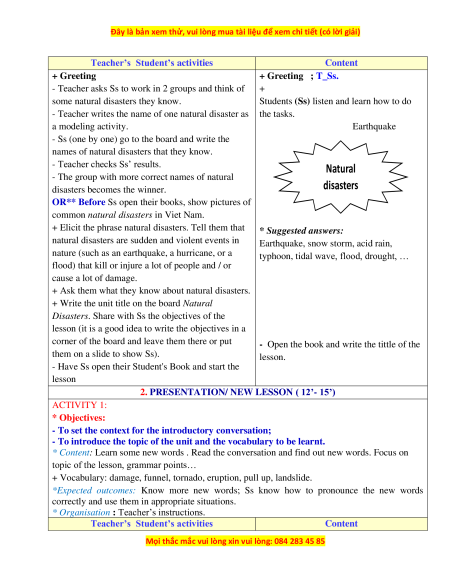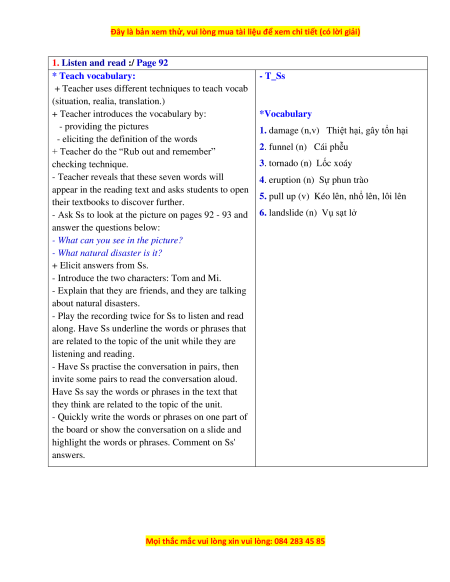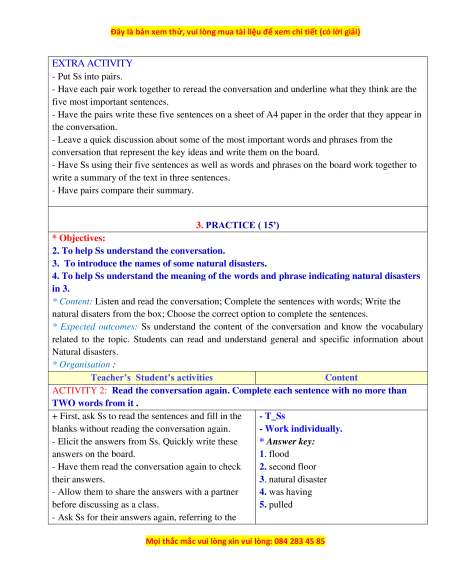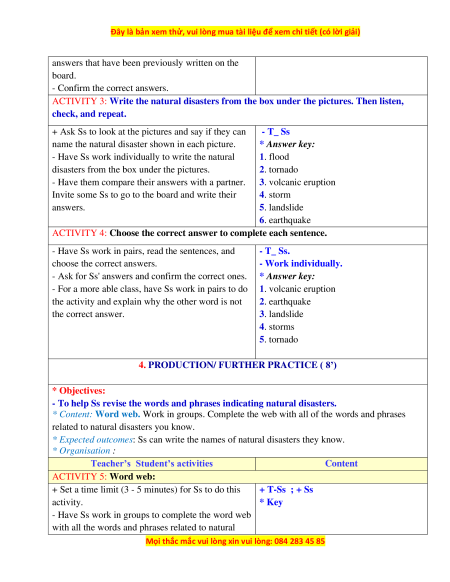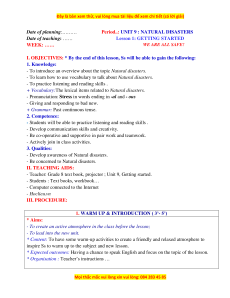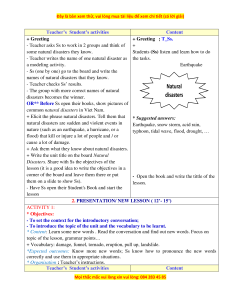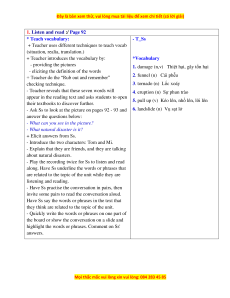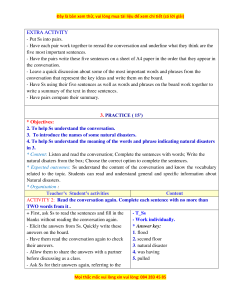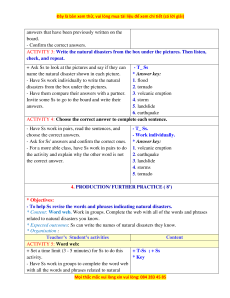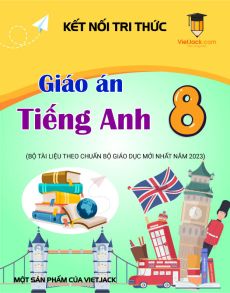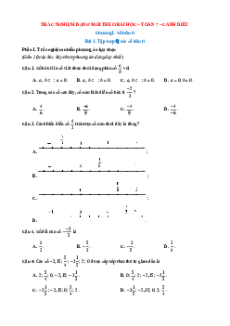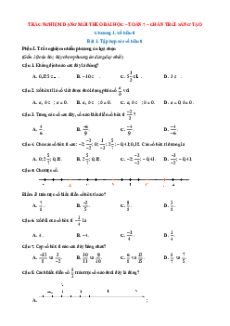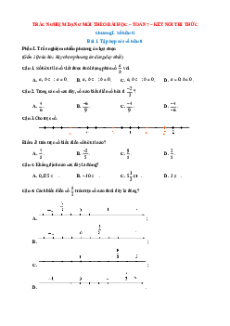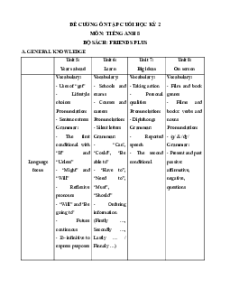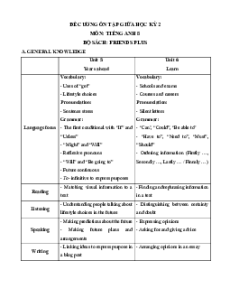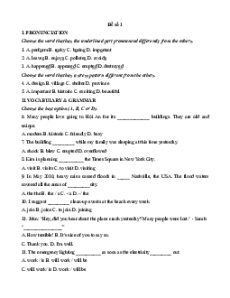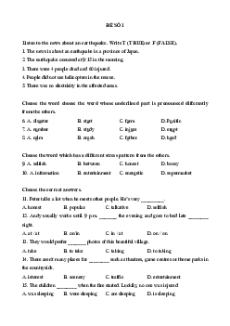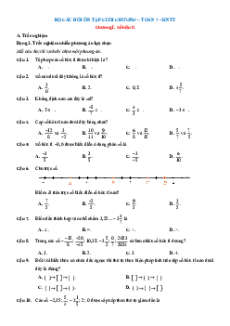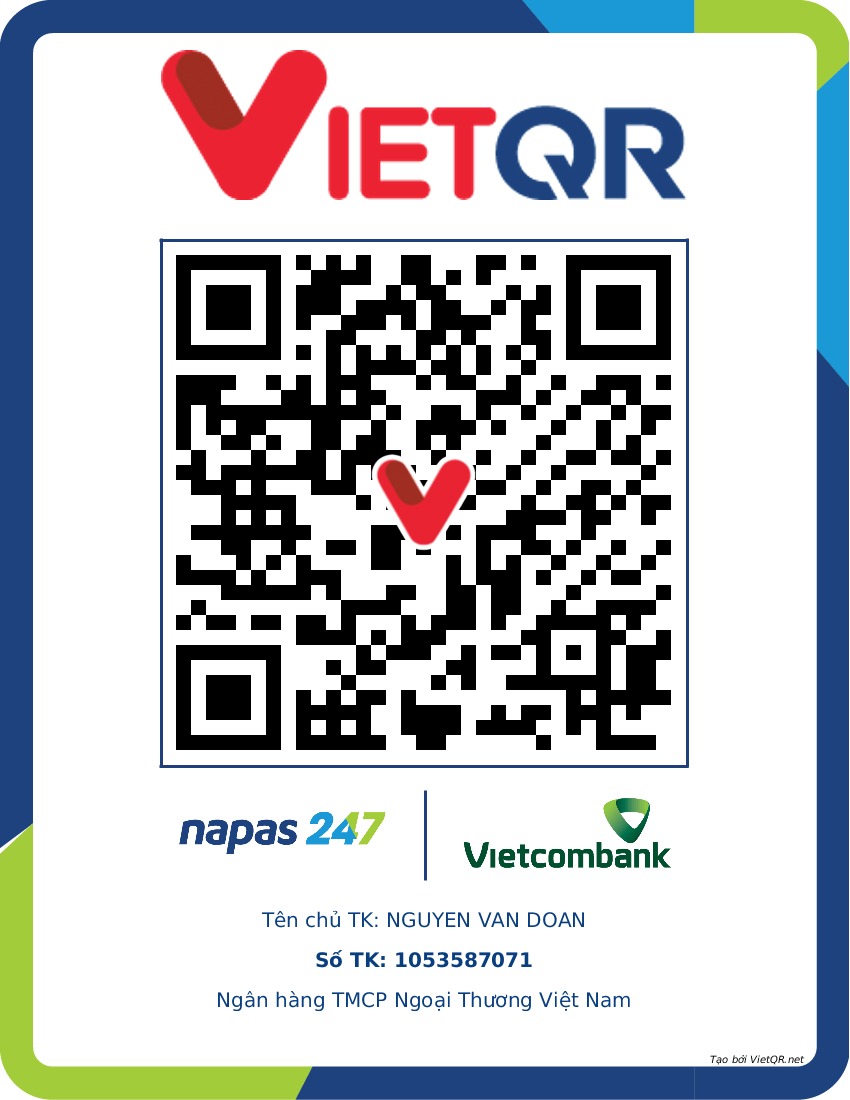Date of planning:……… Period..: UNIT 9 : NATURAL DISASTERS
Date of teaching: ……
Lesson 1: GETTING STARTED WEEK: ……
WE ARE ALL SAFE!
I. OBJECTIVES: * By the end of this lesson, Ss will be able to gain the following: 1. Knowledge:
- To introduce an overview about the topic Natural disasters.
- To learn how to use vocabulary to talk about Natural disasters.
- To practice listening and reading skills .
+ Vocabulary:The lexical items related to Natural disasters.
- Pronunciation: Stress in words ending in -al and - ous
- Giving and responding to bad new.
+ Grammar: Past continuous tense. 2. Competence:
- Students will be able to practice listening and reading skills .
- Develop communication skills and creativity.
- Be co-operative and supportive in pair work and teamwork.
- Actively join in class activities. 3. Qualities:
- Develop awareness of Natural disasters.
- Be concerned to Natural disasters. II. TEACHING AIDS:
- Teacher: Grade 8 text book, projector ; Unit 9, Getting started.
- Students : Text books, workbook…
- Computer connected to the Internet - Hoclieu.vn III. PROCEDURE:
1. WARM UP & INTRODUCTION ( 3’- 5’) * Aims:
- To create an active atmosphere in the class before the lesson; - To lead into the new unit.
* Content: To have some warm-up activities to create a friendly and relaxed atmosphere to
inspire Ss to warm up to the subject and new lesson.
* Expected outcomes: Having a chance to speak English and focus on the topic of the lesson.
* Organisation : Teacher’s instructions …
Teacher’s Student’s activities Content + Greeting + Greeting ; T_Ss.
- Teacher asks Ss to work in 2 groups and think of +
some natural disasters they know.
Students (Ss) listen and learn how to do
- Teacher writes the name of one natural disaster as the tasks. a modeling activity. Earthquake
- Ss (one by one) go to the board and write the
names of natural disasters that they know.
- Teacher checks Ss’ results. Natural
- The group with more correct names of natural disasters becomes the winner. disasters
OR** Before Ss open their books, show pictures of
common natural disasters in Viet Nam.
+ Elicit the phrase natural disasters. Tell them that
* Suggested answers:
natural disasters are sudden and violent events in
Earthquake, snow storm, acid rain,
nature (such as an earthquake, a hurricane, or a
typhoon, tidal wave, flood, drought, …
flood) that kill or injure a lot of people and / or cause a lot of damage.
+ Ask them what they know about natural disasters.
+ Write the unit title on the board Natural
Disasters. Share with Ss the objectives of the
lesson (it is a good idea to write the objectives in a
corner of the board and leave them there or put
- Open the book and write the tittle of the them on a slide to show Ss). lesson.
- Have Ss open their Student's Book and start the lesson
2. PRESENTATION/ NEW LESSON ( 12’- 15’) ACTIVITY 1: * Objectives:
- To set the context for the introductory conversation;
- To introduce the topic of the unit and the vocabulary to be learnt.
* Content: Learn some new words . Read the conversation and find out new words. Focus on
topic of the lesson, grammar points…
+ Vocabulary: damage, funnel, tornado, eruption, pull up, landslide.
*Expected outcomes: Know more new words; Ss know how to pronounce the new words
correctly and use them in appropriate situations.
* Organisation : Teacher’s instructions.
Teacher’s Student’s activities Content
1. Listen and read :/ Page 92 * Teach vocabulary: - T_Ss
+ Teacher uses different techniques to teach vocab
(situation, realia, translation.)
+ Teacher introduces the vocabulary by: *Vocabulary - providing the pictures
1. damage (n,v) Thiệt hại, gây tổn hại
- eliciting the definition of the words
+ Teacher do the “Rub out and remember”
2. funnel (n) Cái phễu checking technique.
3. tornado (n) Lốc xoáy
- Teacher reveals that these seven words will
4. eruption (n) Sự phun trào
appear in the reading text and asks students to open 5. pull up (v) Kéo lên, nhổ lên, lôi lên
their textbooks to discover further.
- Ask Ss to look at the picture on pages 92 - 93 and
6. landslide (n) Vụ sạt lở answer the questions below:
- What can you see in the picture?
- What natural disaster is it? + Elicit answers from Ss.
- Introduce the two characters: Tom and Mi.
- Explain that they are friends, and they are talking about natural disasters.
- Play the recording twice for Ss to listen and read
along. Have Ss underline the words or phrases that
are related to the topic of the unit while they are listening and reading.
- Have Ss practise the conversation in pairs, then
invite some pairs to read the conversation aloud.
Have Ss say the words or phrases in the text that
they think are related to the topic of the unit.
- Quickly write the words or phrases on one part of
the board or show the conversation on a slide and
highlight the words or phrases. Comment on Ss' answers.
EXTRA ACTIVITY - Put Ss into pairs.
- Have each pair work together to reread the conversation and underline what they think are the
five most important sentences.
- Have the pairs write these five sentences on a sheet of A4 paper in the order that they appear in the conversation.
- Leave a quick discussion about some of the most important words and phrases from the
conversation that represent the key ideas and write them on the board.
- Have Ss using their five sentences as well as words and phrases on the board work together to
write a summary of the text in three sentences.
- Have pairs compare their summary. 3. PRACTICE ( 15’) * Objectives:
2. To help Ss understand the conversation.
3. To introduce the names of some natural disasters.
4. To help Ss understand the meaning of the words and phrase indicating natural disasters in 3.
* Content: Listen and read the conversation; Complete the sentences with words; Write the
natural disaters from the box; Choose the correct option to complete the sentences.
* Expected outcomes: Ss understand the content of the conversation and know the vocabulary
related to the topic. Students can read and understand general and specific information about Natural disasters. * Organisation :
Teacher’s Student’s activities Content
ACTIVITY 2: Read the conversation again. Complete each sentence with no more than TWO words from it .
+ First, ask Ss to read the sentences and fill in the - T_Ss
blanks without reading the conversation again.
- Work individually.
- Elicit the answers from Ss. Quickly write these * Answer key: answers on the board. 1. flood
- Have them read the conversation again to check 2. second floor their answers. 3. natural disaster
- Allow them to share the answers with a partner 4. was having before discussing as a class. 5. pulled
- Ask Ss for their answers again, referring to the
Giáo án Unit 9: Natural disasters Tiếng Anh 8 Global success
752
376 lượt tải
MUA NGAY ĐỂ XEM TOÀN BỘ TÀI LIỆU
CÁCH MUA:
- B1: Gửi phí vào TK:
1133836868- CT TNHH DAU TU VA DV GD VIETJACK - Ngân hàng MB (QR) - B2: Nhắn tin tới Zalo VietJack Official ( nhấn vào đây ) để xác nhận thanh toán và tải tài liệu - giáo án
Liên hệ ngay Hotline hỗ trợ: 084 283 45 85
Bộ giáo án Tiếng Anh 8 Global success đã cập nhật đủ Cả năm.
Để tải tài liệu gốc về máy bạn click vào nút Tải Xuống ở trên!
Thuộc bộ (mua theo bộ để tiết kiệm hơn):
- Bộ giáo án Tiếng Anh 8 Global success năm 2024 Tặng kèm bộ tài liệu Đề kiểm tra theo từng unit, đề thi Giữa kì, học kì và bộ bài tập luyện chuyên sâu mới, chuẩn nhất được thiết kế theo phong cách hiện đại, đẹp mắt, trình bày chi tiết cho từng bài học và bám sát chương trình Sách giáo khoa Tiếng Anh 8 Kết nối tri thức.
- Mua trọn bộ sẽ tiết kiệm hơn tải lẻ 50%.
Đánh giá
4.6 / 5(752 )5
4
3
2
1
Trọng Bình
Tài liệu hay
Giúp ích cho tôi rất nhiều
Duy Trần
Tài liệu chuẩn
Rất thích tài liệu bên VJ soạn (bám sát chương trình dạy)
TÀI LIỆU BỘ BÁN CHẠY MÔN Toán Học
Xem thêmTÀI LIỆU BỘ BÁN CHẠY Lớp 8
Xem thêmTài liệu bộ mới nhất

Đây là bản xem thử, vui lòng mua tài liệu để xem chi tiết (có lời giải)
Mọi thắc mắc vui lòng xin vui lòng: 084 283 45 85
Date of planning:………
Date of teaching: ……
WEEK: ……
Period..: UNIT 9 : NATURAL DISASTERS
Lesson 1: GETTING STARTED
WE ARE ALL SAFE!
I. OBJECTIVES: * By the end of this lesson, Ss will be able to gain the following:
1. Knowledge:
- To introduce an overview about the topic Natural disasters.
- To learn how to use vocabulary to talk about Natural disasters.
- To practice listening and reading skills .
+ Vocabulary:The lexical items related to Natural disasters.
- Pronunciation: Stress in words ending in -al and - ous
- Giving and responding to bad new.
+ Grammar: Past continuous tense.
2. Competence:
- Students will be able to practice listening and reading skills .
- Develop communication skills and creativity.
- Be co-operative and supportive in pair work and teamwork.
- Actively join in class activities.
3. Qualities:
- Develop awareness of Natural disasters.
- Be concerned to Natural disasters.
II. TEACHING AIDS:
- Teacher: Grade 8 text book, projector ; Unit 9, Getting started.
- Students : Text books, workbook…
- Computer connected to the Internet
- Hoclieu.vn
III. PROCEDURE:
1. WARM UP & INTRODUCTION ( 3’- 5’)
* Aims:
- To create an active atmosphere in the class before the lesson;
- To lead into the new unit.
* Content: To have some warm-up activities to create a friendly and relaxed atmosphere to
inspire Ss to warm up to the subject and new lesson.
* Expected outcomes: Having a chance to speak English and focus on the topic of the lesson.
* Organisation : Teacher’s instructions …

Đây là bản xem thử, vui lòng mua tài liệu để xem chi tiết (có lời giải)
Mọi thắc mắc vui lòng xin vui lòng: 084 283 45 85
Teacher’s Student’s activities
Content
+ Greeting
- Teacher asks Ss to work in 2 groups and think of
some natural disasters they know.
- Teacher writes the name of one natural disaster as
a modeling activity.
- Ss (one by one) go to the board and write the
names of natural disasters that they know.
- Teacher checks Ss’ results.
- The group with more correct names of natural
disasters becomes the winner.
OR** Before Ss open their books, show pictures of
common natural disasters in Viet Nam.
+ Elicit the phrase natural disasters. Tell them that
natural disasters are sudden and violent events in
nature (such as an earthquake, a hurricane, or a
flood) that kill or injure a lot of people and / or
cause a lot of damage.
+ Ask them what they know about natural disasters.
+ Write the unit title on the board Natural
Disasters. Share with Ss the objectives of the
lesson (it is a good idea to write the objectives in a
corner of the board and leave them there or put
them on a slide to show Ss).
- Have Ss open their Student's Book and start the
lesson
+ Greeting ; T_Ss.
+
Students (Ss) listen and learn how to do
the tasks.
Earthquake
* Suggested answers:
Earthquake, snow storm, acid rain,
typhoon, tidal wave, flood, drought, …
- Open the book and write the tittle of the
lesson.
2. PRESENTATION/ NEW LESSON ( 12’- 15’)
ACTIVITY 1:
* Objectives:
- To set the context for the introductory conversation;
- To introduce the topic of the unit and the vocabulary to be learnt.
* Content: Learn some new words . Read the conversation and find out new words. Focus on
topic of the lesson, grammar points…
+ Vocabulary: damage, funnel, tornado, eruption, pull up, landslide.
*Expected outcomes: Know more new words; Ss know how to pronounce the new words
correctly and use them in appropriate situations.
* Organisation : Teacher’s instructions.
Teacher’s Student’s activities
Content
Natural
disasters

Đây là bản xem thử, vui lòng mua tài liệu để xem chi tiết (có lời giải)
Mọi thắc mắc vui lòng xin vui lòng: 084 283 45 85
1. Listen and read :/ Page 92
* Teach vocabulary:
+ Teacher uses different techniques to teach vocab
(situation, realia, translation.)
+ Teacher introduces the vocabulary by:
- providing the pictures
- eliciting the definition of the words
+ Teacher do the “Rub out and remember”
checking technique.
- Teacher reveals that these seven words will
appear in the reading text and asks students to open
their textbooks to discover further.
- Ask Ss to look at the picture on pages 92 - 93 and
answer the questions below:
- What can you see in the picture?
- What natural disaster is it?
+ Elicit answers from Ss.
- Introduce the two characters: Tom and Mi.
- Explain that they are friends, and they are talking
about natural disasters.
- Play the recording twice for Ss to listen and read
along. Have Ss underline the words or phrases that
are related to the topic of the unit while they are
listening and reading.
- Have Ss practise the conversation in pairs, then
invite some pairs to read the conversation aloud.
Have Ss say the words or phrases in the text that
they think are related to the topic of the unit.
- Quickly write the words or phrases on one part of
the board or show the conversation on a slide and
highlight the words or phrases. Comment on Ss'
answers.
- T_Ss
*Vocabulary
1. damage (n,v) Thiệt hại, gây tổn hại
2. funnel (n) Cái phễu
3. tornado (n) Lốc xoáy
4. eruption (n) Sự phun trào
5. pull up (v) Kéo lên, nhổ lên, lôi lên
6. landslide (n) Vụ sạt lở

Đây là bản xem thử, vui lòng mua tài liệu để xem chi tiết (có lời giải)
Mọi thắc mắc vui lòng xin vui lòng: 084 283 45 85
EXTRA ACTIVITY
- Put Ss into pairs.
- Have each pair work together to reread the conversation and underline what they think are the
five most important sentences.
- Have the pairs write these five sentences on a sheet of A4 paper in the order that they appear in
the conversation.
- Leave a quick discussion about some of the most important words and phrases from the
conversation that represent the key ideas and write them on the board.
- Have Ss using their five sentences as well as words and phrases on the board work together to
write a summary of the text in three sentences.
- Have pairs compare their summary.
3. PRACTICE ( 15’)
* Objectives:
2. To help Ss understand the conversation.
3. To introduce the names of some natural disasters.
4. To help Ss understand the meaning of the words and phrase indicating natural disasters
in 3.
* Content: Listen and read the conversation; Complete the sentences with words; Write the
natural disaters from the box; Choose the correct option to complete the sentences.
* Expected outcomes: Ss understand the content of the conversation and know the vocabulary
related to the topic. Students can read and understand general and specific information about
Natural disasters.
* Organisation :
Teacher’s Student’s activities
Content
ACTIVITY 2: Read the conversation again. Complete each sentence with no more than
TWO words from it .
+ First, ask Ss to read the sentences and fill in the
blanks without reading the conversation again.
- Elicit the answers from Ss. Quickly write these
answers on the board.
- Have them read the conversation again to check
their answers.
- Allow them to share the answers with a partner
before discussing as a class.
- Ask Ss for their answers again, referring to the
- T_Ss
- Work individually.
* Answer key:
1. flood
2. second floor
3. natural disaster
4. was having
5. pulled

Đây là bản xem thử, vui lòng mua tài liệu để xem chi tiết (có lời giải)
Mọi thắc mắc vui lòng xin vui lòng: 084 283 45 85
answers that have been previously written on the
board.
- Confirm the correct answers.
ACTIVITY 3: Write the natural disasters from the box under the pictures. Then listen,
check, and repeat.
+ Ask Ss to look at the pictures and say if they can
name the natural disaster shown in each picture.
- Have Ss work individually to write the natural
disasters from the box under the pictures.
- Have them compare their answers with a partner.
Invite some Ss to go to the board and write their
answers.
- T_ Ss
* Answer key:
1. flood
2. tornado
3. volcanic eruption
4. storm
5. landslide
6. earthquake
ACTIVITY 4: Choose the correct answer to complete each sentence.
- Have Ss work in pairs, read the sentences, and
choose the correct answers.
- Ask for Ss' answers and confirm the correct ones.
- For a more able class, have Ss work in pairs to do
the activity and explain why the other word is not
the correct answer.
- T_ Ss.
- Work individually.
* Answer key:
1. volcanic eruption
2. earthquake
3. landslide
4. storms
5. tornado
4. PRODUCTION/ FURTHER PRACTICE ( 8’)
* Objectives:
- To help Ss revise the words and phrases indicating natural disasters.
* Content: Word web. Work in groups. Complete the web with all of the words and phrases
related to natural disasters you know.
* Expected outcomes: Ss can write the names of natural disasters they know.
* Organisation :
Teacher’s Student’s activities
Content
ACTIVITY 5: Word web:
+ Set a time limit (3 - 5 minutes) for Ss to do this
activity.
- Have Ss work in groups to complete the word web
with all the words and phrases related to natural
+ T-Ss ; + Ss
* Key

Đây là bản xem thử, vui lòng mua tài liệu để xem chi tiết (có lời giải)
Mọi thắc mắc vui lòng xin vui lòng: 084 283 45 85
disasters they know. Tell Ss that they can include
the words and phrases learnt in this lesson or other
words and phrases. Invite some Ss to share their
group's answers with the class.
+ For a more able class, after Ss have finished the
word web, ask them to make some sentences with
the words and phrases they have written.
5. WRAP-UP & HOME WORK (2’)
+ Ask one or two Ss to tell the class what they have learnt. Draw Ss' attention to the objectives
on the board or show them the slide with the objectives. Tick the objectives that have been
learnt.
+ Ask Ss to say aloud some words and phrases they remember from the lesson.
+ If there is a projector in the classroom, show the the conversation in 1 and highlight the
keywords related to the topic. It would be helpful to also highlight the past continuous and the
words ending in -at and -ous. Tell Ss that they will learn these language points in the upcoming
lessons
* HOME WORK:
- Do more exercises in workbook.
- Prepare new lesson: Lesson 2: A CLOSER LOOK 1 .
** Prepare for the Project of the unit:
Teacher randomly puts Ss in groups of 4 or 5 and asks them to brainstorm about a serious pollution
problem in their areas and solutions to the problem, then make a poster about it. Students will show and
present their posters in Lesson 7 – Looking back and Project. (Teacher should check the progress of
students’ preparation after each lesson.)
==============================================
